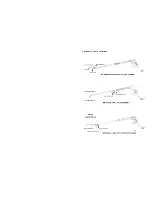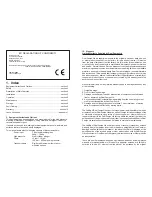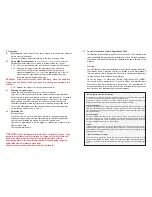
6. Operation
6.1
Start engine
(Note:
Depress the lance trigger to release water pressure
before starting the engine).
Refer to accompanying booklet relating to the type of engine fitted.
6.2
Using High Pressure Lance
(Note: See Appendix 1 for lance type and operation)
Release the lance safety catch, which is located behind the trigger.
6.2.2 Point the lance downwards and towards the object being cleaned.
6.2.3 Squeeze, the trigger to start the high-pressure jet, proceed to
wash the object. Adjust the working pressure by turning the
pressure regulator knob + or - to suit the application (fig 2, item 13).
Never direct the high-pressure stream at the engine or pump as
this could cause irreparable damage.
WARNING:
-
High-pressure lances react ‘Kick Back’ when the operating
trigger is pulled. Ensure you have a good firm footing and anticipate this
reaction.
6.2.4 Release the trigger to stop the high-pressure jet.
6.3
Washing using detergent
Attach the detergent induction pipe to the power washer,
(fig 2, item 1) placing the opposite filter end into the detergent container.
Select the low pressure setting on the lance, (see appendix 1 for details
of your lance) and spray the water/detergent mixture onto the object
being cleaned. Leave the detergent for the period recommended by the
chemical manufacturer allowing it time to work, washing off with clean water.
The volume of detergent used can be controlled by means of the regulator
on the suction valve (see fig 2. item 3).
6.4
Switching Off
Release trigger.
Stop drive engine, (refer to additional literature / handbook supplied,
relating to the type of engine fitted, remembering to switch off ignition after
use to prevent draining the battery, electric start models only).
Depress the high-pressure lance’s trigger to release the pressure in the
high-pressure hose.
Disconnect water supply.
WARNING
: Do not let the pump idle in By-Pass for lengthy periods, if you
intend to break from work for more than 5 minutes, switch the machine off.
Should the machine run for longer period, the temperature of the re-
circulating water will increase rapidly and could risk damaging the pump
seals. (Models with internal by-pass only).
Running power washers should never be left unattended.
3.5
Control of Vibration at Work Regulations 2005
This machine in its standard form dose not exceed the 2.5 m/s² vibration action
value and should not require any daily limitations to it use. Periodic equipment
checks and servicing will maintain the characteristics and efficiency of this
machine.
Warning:
Any modifications or accessories added or use with this machine may affect
the vibration levels. Under the Control of Vibration at Work Regulations it
is the employers duty to manage the exposure to vibration and implement
training and health surveillance for employees.
Under the Supply of Machinery (Safety) Regulations1992 (SMSR),
you should ensure equipment is in good condition and maintained in
accordance with the manufacturers instructions, any modifications or
accessories added to this machine should be assessed for safe operation
and vibration, then implement appropriate measures.
* Note: Goggles or Full Face Protection.
The wearing of eye and face protection in hazardous areas is a requirement under regulation
4 of the personal protective equipment at work regulations 1992.
Regulation 4 requires employers to provide suitable personal protective equipment to
employees who may be exposed to risks affecting their health and safety.
Full Face Protection.
High speed flying partials or chemical splashes are rarely aimed directly at the eyes. A full
face visor offers the maximum protection in extreme conditions. Full face shields offer a wide
area of protection and because of the all round ventilation, remain mist free even in wide
temperatures swings.
Chemical Splash.
Chemical splashes and vapours can hit you from all sides. It’s important that full eye
enclosure is selected, e.g. Unvented goggles. Full face shields will also protect the whole
face from liquid splashes. Those with chin guards should be selected where there is a
danger of splash deflecting up from work surfaces.
Impact.
Impact hazards are caused by fast moving particles from the cleaning operation. The
potential impact speed must be assessed before selecting the most appropriate protection.
Safety glasses could be dislodged by high velocity impacts, in which case goggles or face
shield should be selected.
** Note: Ear Muffs or Ear Plugs.
The noise at work regulations require that from February 2006 persons working in noise
levels between 80dBA and 85dBA must be provided with suitable hearing protection on
request. If noise levels are above 85dBA then hearing protection must be supplied and
worn.


























